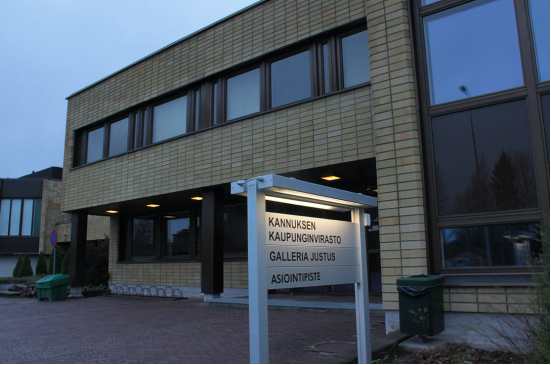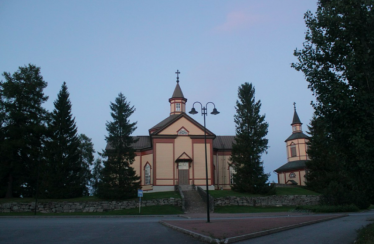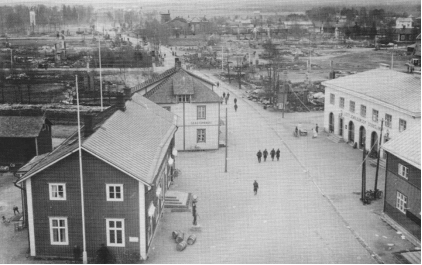Kannus 作者: 来源: 发布时间:2021-10-15
一、所属省或是州,具体位置,人口,面积
Kannus is a town and municipality and city of Finland. It is situated in the province of Western Finland and is part of the Central Ostrobothnia region. The municipality has a population of 5,499 (31 January 2019) and covers an area of 470.65 square kilometres (181.72 sq mi), of which 2.41 km2 (0.93 sq mi) is water. The population densityis 11.74 inhabitants per square kilometre (30.4/sq mi). Neighbour municipalities are Kalajoki, Kokkola, Sievi and Toholampi. The municipality is unilingually Finnish.The city is located along the Ostrobothnian line, and despite the small size of the city, several trains stop at Kannus station. Kannus' best-known and largest companies include Pouttu Oy, Eskopuu Oy and Kannustalo Oy. The local Lestijoki newspaper is published in Kannus.

二、自然地理
1.地理条件
The landscape of Kannus is characterized by flat terrain, numerous swamps and river valleys. The bedrock is mainly mica gneiss. Other rock types include gabbro and anorthosite. There are few rock outcrops. The most common type of soil is the moraine, which is often covered under peat layers. The moraine forms southeast-northwest ridges and ridges. In the northwestern part of the city there is an abundant moraine area. Sorted mineral is mainly found only in river valleys. In the valley of the Lestijoki river, there are flood layers several meters thick, under which there is clay. To the south, the Hietaseljänharju stretches into the city area, from where the washed-out curved embankments protrude from the swamp as backs. Nearly half of the city’s area is swampy, but most of the bogs are drained. Just to the north is an extensive thin peat and undrained marshland. Elevation differences are small in the city area. The terrain spends towards the Gulf of Bothnia coast and river valleys. The lowest points of the river valley are about 29 meters high and the moraine hills of the southern and eastern parts are just over a hundred meters high. The highest elevation of the city reaches a height of 113 meters.
The northern border of the city has Hietajärvi and a few forest ponds. The main river is the Lestijoki River, which flows from southeast to northwest, and flows in a ten-meter-deep canyon for miles. Koskinen Lestijoki is a popular boating and canoeing route. The city's other rivers are the meandering Viirrejoki in the south and the Pöntiönjoki, Kärkisoja and Ahmasoja in the north.
2.交通情况
Kannus railway station stopped ticket selling at the beginning of year 2009. Tickets are available: from the train, from the internet from the web store of VR or the ticket machine which is located next to the station, R-Kioski after you have made reservation from VR phone service 0600 41900 (1E/call + local net payment) and you can have against the reservation number from R-Kioski. Waiting area of the railway station is open from Mo to Fri from 6.30 am to 9pm.
三、经济发展和规模
Municipal money means the share of support funding granted by the municipality for development projects, the main funding of which comes from the EU and the state. Municipal money is about 20% of the support granted to the project. Municipal money is paid by the municipality in whose territory the development project is implemented. The Municipal Finance fee for a project implemented in a wider area is divided, for example, on the basis of the population or the participants in the project, to be taken care of by different municipalities. Municipal funding is granted for development projects that help several beneficiaries (for example, companies). Municipal funding is not granted for projects of individual companies.
http://www.kpkuntaraha.fi/Default.aspx?ReturnUrl=%2f
四、产业特点/重点项目
Kokkolanseudun Kehitys Oy KOSEK is a business and development company owned by the City of Kokkola and the Municipality of Perho. KOSEK's main tasks are business advice and regional development. We serve companies in matters related to location and business premises, staff training and recruitment, financing, research and development projects, internationalization or changes of ownership. The business consulting process is always different and of different lengths depending on the company and the business challenge it faces. Together with you, we will solve the challenge and look for the most effective solution. Then we look at what is the best funding model and who are the right experts. KOSEK will go by your side and monitor the progress of the process.
In Tallqvist's family business, which operates in the civil engineering and transport industries, the third generation is gradually moving to the driver's seat. The company is also increasingly seeking markets from the private sector.
The aim of the project is to support the development and growth of Central Ostrobothnian tourism companies, and to increase the visibility and attractiveness of Central Ostrobothnian nature tourism. Development is supported by supporting the product development of companies, the quality of products and services, and the introduction of digital sales channels. Networking between companies brings opportunities for mutual sparring and the creation of joint product packages. The opportunities for nature tourism in Central Ostrobothnia are highlighted through common visibility and experiments with different marketing channels. Since the project, the companies' business has developed and employability has improved, the companies are implementing marketing measures together and the attractiveness of nature tourism in Central Ostrobothnia has increased.
https://www.kosek.fi
http://www.kpkuntaraha.fi/Default.aspx?ReturnUrl=%2f
五、风景名胜,景点( attractions)
1. Kannus Church

Kannus Church is a wooden cruciform church in the center of Kannus near Highway 28 and the Lestijoki River. The current church, built in 1817 under the leadership of Heikki Kuorikoski, is the third in Kannus. Other parish facilities include the St. Michael's Chapel in the cemetery, the parish house and the Laurentius Hall, the rectory and the Eskola prayer room, the Poleenharju Forest Church and the Ruona camp center on the shores of the Gulf of Bothnia.
The second church in Kannus, built by Matti Honga, was completed in 1761. It had an altarpiece by Mikael Toppelius from 1765. The church burned down by lightning on July 30 or 31, 1813.
Today, the Church of Kannus hosts services every Sunday and the church is a road church during the summer season. The current church in Kannus celebrated its 200th anniversary in 2017, as a result of which the Kannus parish organized several anniversary events.
2.Kannus Museums
Mäkiraonmäki is the only one unity, besides the church, that was saved from the big fire in 1934 that happened in the centre. In the area there are many valuable buildings like Kannus työväentalo which is owned by the Oskari Tokoi organization, Kuntala (old city hall), lainamakasiini (operating as local history museum) Joosep house, Topia house, Aapa house and other Ostrobothnian old style houses. At this area there are also remains of handcraft habitants and others, which was typical for old centre. Mäkiraonmäki buildings are still nearly in the locations where they were originally built, part of them is restored and historically valuable.
Local history museum open in June-July when Aapa coffee house is open. From this museum you can find, for example, objects from peasant culture. In addition they have managed to get full village cobbler’s objects to the museum. Museum has three floors and it is build from logs. It operated as storehouse for grain. The building is known by the names of Viljamakasiini (grain storage) and Lainamakasiini. Local history museum was opened in 1991. Opening hours are notified along the Mäkiraonmäki summer events.
Oskari Tokoi-museum open in June-July when Aapa coffee house is open. This museum is situated to the downstairs of Työväentalo and is a tribute to Senator-minister-spokesman-council man mr. Oskari Tokoi’s life work. The old janitor’s room operates as an immigrant museum. In Oskari Tokoi-museum there is wide selection of pictures and newspaper clips as well as an old typing machine of mr. Tokoi which he got from America. Contact person: The chairman of the Oskari Tokoi organization mr. Manu Kumpulainen.
Kannus School Museum was opened along with the native region days in Lestijoki Region the 5th August, 2004. The School Museum is situated at the Monitoimitalo, in the centre of Kannus, address: Book a guide and get a tour in the Museum. You can book it from the city hall, from the cultural office or from mr. Heikki P, As far as it is known there are no other school museums at Ostrobothnian region. The forest railway museum, which is located next to Eskola village house is an interesting and even nationally special destination to visit.
https://www.kannus.fi/culture/museums
3. Gallery Justus
Gallery Justus is situated to the downstairs of the city hall, Asematie 1. There are exhibitions with different subjects each month. Also there are ongoing show and a miniature of the village of Mutkalampi. Exhibitions are part of the cultural activities of the Kannus city. Gallery Justus is open Mon-Fri in the opening hours of the city hall, and also on Sunday at 1pm-4pm.
Justus Sarisalo (1902-1985, Staudinger 1902-1936) was born in Fichburg in the U.S in 1902 . His family moved to Finland a couple of years later, first to Himanka and then to Kannus. He got married in 1922 and had four children. In 1949-1968 Justus Sarisalo worked as an art teacher in Kannus. From 1968 he was a free artist. In 1945 Justus Sarisalos first art works were in an exhibition in Kokkola. After that his works were in several exhibitions, e.g. in Helsinki, Kannus, and Vaasa. His first own exhibition was held in Kokkola in 1949. In the following years he had many exhibitions around Finland, and he did some study trips also abroad (to Germany, Holland, France, and Italy). Justus Sarisalos art works are mainly oil paintings but also pastel works and charcoal drawings. He continued painting to his last days. He got ill and died at his daughters home in Kokkola in 1985. The Justus Sarisalo Art Foundation was founded in 1986 to protect his art works and keep them in one place (in the Town Hall of Kannus). More information on Justus Sarisalos life is found in Finnish at the www-sites of Kannus.
https://www.kannus.fi/culture/gallery-justus
六、历史文化
1.历史
Stone Age discoveries have been made in the Kannus region. The oldest Stone Age finds are located in the times of Suomusjärvi culture. The residence during the comb ceramic culture has been found in Polvikoski, the village of Ylikannus. At the end of the comb-ceramic culture, the Lestijoki valley seems to have lost its settlement, as very little is known about the discoveries of the late Stone Age. The desertification of the area may have been due to the change in the area due to the relocation of the coast, which is unfavorable for sea fishing. Certain Bronze Age finds are not known in the Lestijoki area. It would seem that the area has lost permanent housing after the Iron Age and turned into a wilderness area where only the Sámi and their taxpayers moved. Gradually, wilderness settlers from Satakunta and Kainuu settled in the wilderness, whose enjoyment countries included the countries of Central Ostrobothnia.
At the beginning of the 15th century, Kannus belonged to the Suur-Pedersöre area. It was later incorporated into the Great Lohtaja. In the late Middle Ages, Kannus grew into the largest village in Suur-Lohtaja, with thirty houses scattered on the banks of the Kannusjoki River, now Lestijoki, from the mouth to Toholammi. Possibly a foreign nationality was represented in the 1540s by Juho Holsti aka Alli, a resident of Kannuskylä, whose house is difficult to identify with any later house. As early as 1540, Holst's immediate neighbors at the mouth of the Lestijoki River were inhabited by brothers Olli and Lauri Pietarinpojat, whose houses were later called Polish (both Puolacka and Pålack were written). At the end of the Middle Ages, about a dozen families lived in Ovannann, the area of the present parish of Kannus. When Ala- and Ylikannus were first marked as different villages around 1560, there were 19 houses in each. The settlement of Mutkalampi was also reduced to Alakannus in the 16th century. The meandering pond was separated into its own village at the beginning of the 17th century, but its survival for so long in connection with Alakannus shows from where it was mainly inhabited. It was not until the 1620s that Kannus was regularly marked in the tax records as a separate village from Alakannus, which was renamed Hillilä in the 1640s. In the Lestijoki Valley, settlement activity came to a halt at the beginning of the 17th century, all the way to Ylikannu. In 1608 there were a total of 51 houses in Kannuskylä, Hillilä, Välikannus and Ylikannus and in 1690 only one more or 52 houses.

In the 17th century, ironmaking became an important side income for the peasants of Cannus. The state also drew attention to the iron soil of the Lestijoki Valley and in 1642 granted privileges to establish Rautaruukki in the area. However, the ironmaking of the Lestijoki Valley did not get its start from those privileges. Instead, it seems that the founders of Kokkola in particular contributed to the revival of iron production in the region. The peasants made anchors and other larger forging works using hydro-powered hammers that were private or shared by several houses. Tar production has also been very important for farmers in the region.
2. 文化体育
Kannus city provides teaching- and education services such as early childhood education, basic education, upper secondary school, folk college and basics for art. In addition the city is a member of Central Ostrobothnia Municipal Education and Training Consortium which is responsible for vocational education. The highest decision making organ is the board for educational services which consists of 9 members. Total amount of employees in different units is 140. Budget for it is about 10,5 million euros. In the 1980s, lazy porridge, or barley porridge with a sweet soup or raisin soup, was named the custard's food.
Kannus Ura is a Sports Club founded in 1968 in Kannus with activities in skiing, orienteering, athletics, baseball, football, kendo, floorball and hockey. In baseball, the career women played in the main series in the 1976 season.The sports clubs Kannus operating in Kannus and Kannus Pilke started merger negotiations at the end of 1967, both of whom stated that joining forces was a sensible and realistic option. At the meeting of the Kannus Athletes' Board on November 6, 1967, Jorma Pouttu, Martti Eskola and Jussi Luhala were elected to negotiate with Pilkke about the merger.
At the next meeting of the Kannus Athletes' Board, a month later, it was noted that the general opinion of the membership was in favor of the reunification, and the Board was quite broadly in agreement. On 28 January 1968, the general meeting of the club unanimously decided to abolish the old clubs mentioned above and to replace them with a new one. When Pilke ended up doing the same thing, the practical steps were ready to begin in the winter and spring of 1968.
At the last two meetings of the Kannus Athletes on May 3 and 21, 1968, it was noted that the Athletes and Pilkke had ceased their activities and that the competitive and other sports activities included in their program had been transferred to a completely new club, the Kannus Career.
七、其他信息
According to the 2018 regional division, there is only one parish in the Evangelical Lutheran Church of Finland, Kannus Parish. Among the revival movements within the church, there is evangelism, awakening and Vanhoillislestadism in the locality, which has the Kannus Peace Association in the locality. Other denominations are represented by the Pentecostal Church of Kannus, part of the Pentecostal revival, and the Baptist Church of Kannus, which represents Baptism. Of the parishes of the Finnish Orthodox Church, the Vaasa Orthodox Parish operates in the Kannus area.
八、联系方式
Town manager: Terttu Korte
Phone: 06 8745 111
Email: vkannus.kaupunki@kannus.fi
Address: PL 42 (käyntiosoite: Asematie 1) 69101 KANNUS
https://www.kannus.fi
